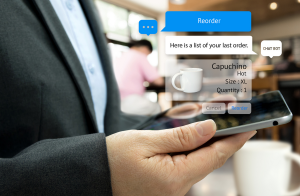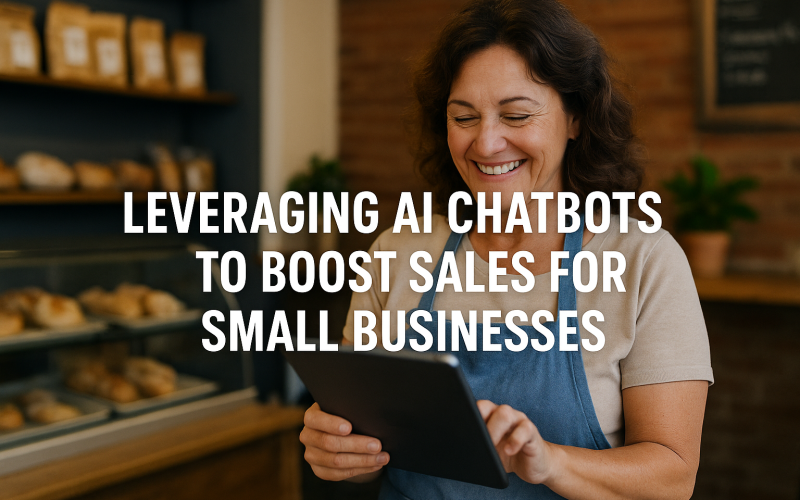Introduction
AI chatbots are changing how small businesses connect with customers. These virtual assistants answer questions, guide shoppers, and even close sales—all without needing a human at every moment. For many small companies, hiring full-time support staff is expensive and slow. Chatbots help fill gaps, offering instant responses around the clock. In 2025, customers expect quick, personalized experiences online. An AI chatbot can greet visitors the moment they land on your site, suggest products based on needs, and ease the buying process. This article shows how small businesses can leverage AI chatbots to boost sales, improve customer satisfaction, and save time. You will learn what chatbots can do, the benefits they bring, how to choose and implement a solution, and tips to measure success. By the end, you will be ready to add a smart chatbot to your team and watch your sales grow.
Natural-language bots greet shoppers 24/7, suggest products, and even accept payments—all without adding payroll. For solo founders and family shops, this always-on helper can raise sales while freeing human staff for high-value tasks. This guide explains, in clear words, how small businesses can set up, train, and profit from AI chatbots. You will learn best features, quick wins, and mistakes to avoid, so your digital helper delights customers and drives revenue, not frustration.
What Is an AI Chatbot?
An AI chatbot is a software tool that simulates human conversation. It uses artificial intelligence to understand customer messages and respond in real time. Unlike simple rule-based bots that follow fixed scripts, AI chatbots learn from every interaction. They use natural language processing (NLP) to interpret user intent and offer relevant answers or actions.
Most AI chatbots connect to your website or social media pages. When a visitor types a question, the bot analyzes the text and finds the best response from a knowledge base. If the bot cannot answer, it can hand off the conversation to a human agent or collect contact details for follow-up. Over time, AI chatbots improve by learning from past chats and customer feedback.
AI chatbots come in many forms: text-based chat windows, voice assistants, or messaging apps. They can work on desktops, tablets, or smartphones, meeting customers wherever they prefer to communicate. With simple setup, small businesses gain a powerful tool that mimics a live support team, operating 24/7 without extra staffing costs.
Benefits of AI Chatbots for Small Businesses

AI chatbots deliver measurable advantages for small businesses aiming to boost sales and enhance customer satisfaction. Here are the key benefits.
First, chatbots offer instant responses. Modern shoppers expect quick answers to product questions and pricing. A chatbot that replies in seconds reduces frustration and cart abandonment. Customers stay on your site longer when they feel heard.
Second, chatbots drive lead generation. By asking a few qualifying questions, a chatbot identifies potential buyers. It can capture email addresses and phone numbers for follow-up, boosting sales prospects. This automation frees human staff to handle high-value tasks.
Third, chatbots improve conversion rates. Personalized product suggestions based on user input lead to more sales. If a visitor mentions interest in running shoes, the chatbot can showcase top-rated models and offer a discount code, subtly guiding the purchase.
Fourth, chatbots reduce support costs. A well-trained bot handles common questions—like store hours, return policies, or tracking orders—without human intervention. This lowers staffing needs and speeds resolution times.
Finally, chatbots gather valuable data. Every interaction records customer preferences and pain points. You can mine this data to improve products, refine marketing, and tailor promotions. Over time, these insights boost sales and customer loyalty.
Use Cases: Enhancing Sales through Chatbots

AI chatbots can play several roles in the sales process. Here are three high-impact use cases for small businesses.
Lead Generation
Turning website visitors into leads is critical. A chatbot pops up when a visitor lingers on a page for more than a few seconds. It greets them with “Can I help you find something?” Then it asks a question like, “Looking for women’s jackets or men’s jackets today?” Based on answers, the bot offers relevant pages or asks for an email to send deals. It can also schedule a live chat or callback. This method captures leads who might otherwise leave without engagement.
Customer Support and Retention
Excellent support drives repeat sales. Chatbots handle FAQs around the clock—order status, return process, sizing guides—without wait times. For complex issues, the bot seamlessly transfers chats to human agents with full context. Fast, consistent help builds trust. Satisfied customers are more likely to buy again, refer friends, and leave positive reviews, fueling long-term growth.
Up-Selling and Cross-Selling
Chatbots boost average order value by recommending accessories or complementary items. When a customer adds a DSLR camera to their cart, the bot suggests a memory card or camera bag. It can offer bundle discounts or highlight limited-time deals. Smart suggestions feel helpful when timing is right, increasing order size and revenue without aggressive sales tactics.
Choosing and Implementing an AI Chatbot

Selecting and deploying a chatbot requires planning and careful choice of features. Follow these steps to succeed.
Evaluate Your Needs
First, identify your goals. Do you need lead capture, support automation, or sales assistance? Estimate chat volume and decide if you want voice or text chat. Outline key customer questions and scenarios. This list guides feature selection and training.
Compare Chatbot Platforms
Many platforms cater to small businesses. Some top options include Chatfuel, ManyChat, MobileMonkey, and Ada. Look for ease of use, integration with your website or Facebook Messenger, and pricing. Check if the platform offers NLP, analytics, CRM integration, and built-in templates. Trial free versions to test bot creation and conversation flow design.
Design Conversation Flows
Map out customer journeys. Start with greeting messages and menu options for shopping, support, and deals. Create scripts for common queries: product availability, order tracking, store hours. Use simple language and clear options. Include fallback responses—“I’m sorry, I don’t understand. Can I connect you with a live agent?” Test flows internally to catch dead ends and confusing loops.
Integrate with Existing Systems
For seamless operation, connect your chatbot to key systems. Link to your CRM (like HubSpot or Salesforce) so leads are captured automatically. Integrate with inventory management to reflect real-time stock. Tie into payment gateways for in-chat purchases if possible. A unified setup ensures bots deliver accurate and efficient service.
Train Your Bot Continuously
AI chatbots improve with training. Review chat transcripts weekly to spot misunderstood queries. Add new responses and refine existing ones. Use customer feedback surveys at the end of chats—“Was this answer helpful?”—to refine accuracy. Over time, the bot handles more complex conversations and increases self-service rates.
Measuring Success and ROI

To know if your chatbot boosts sales, track key metrics and ROI. Use these measures to evaluate performance.
First, monitor chat engagement: number of sessions, messages exchanged, and unique users. A rise in engagement means more site visitors talk to your bot.
Second, track lead capture rates. Compare the number of leads collected through the bot versus other channels. A higher conversion on chat forms signals effective lead generation.
Third, measure sales influenced by the chatbot. Use UTM codes or tracking pixels in links shared by the bot. See how many purchases originated from chatbot interactions.
Fourth, analyze customer satisfaction. Use post-chat surveys to rate satisfaction. A 4- or 5-star rating indicates positive experiences. Address low scores by improving conversation flows and training data.
Fifth, calculate cost savings. Estimate human support hours saved by bot handling common queries. Multiply hourly wages by hours saved to gauge cost reduction.
Finally, compare overall ROI by balancing increased sales, saved costs, and platform fees. If revenue growth and savings exceed platform costs, your chatbot investment pays off.
Setting Up Your First Bot: Step-by-Step
1. Map Core Customer Questions
Pull FAQs from email logs and support tickets. Group into: shipping, sizing, returns, product care.
2. Write Friendly Template Answers
Keep answers short—two to three sentences—plus a link or button to deeper info.
3. Pick a Personality
Match your brand. A playful boutique might use emojis; a legal consultant sticks to formal tone. Stay consistent.
4. Train the NLP Model
Feed at least five variants of each question: “Where is my order?” “Track parcel,” “Package status?” Better data means fewer misunderstandings.
5. Set Handoff Rules
When confidence drops below 70 %, or user types “agent,” route to human. Nothing hurts trust like a bot that loops nonsense.
6. Add Sales Flows
Cart abandon recovery: after 30 minutes idle, bot offers 10 % coupon.
Product finder: asks budget, purpose, preference, then shows three items with “Add to cart.”
7. Launch and Monitor
Enable on low-traffic pages first. Review chat logs daily. Tweak answers where users still ask follow-up questions.
Table: Chatbot Platform Feature Comparison
| Platform | NLP Capability | CRM Integration | Pricing | Best Use Case |
|---|---|---|---|---|
| Chatfuel | Basic | Facebook Pages | Free/$15+ per month | Simple Facebook bots |
| ManyChat | Advanced | Shopify, Zapier | Free/$10+ per month | E-commerce engagement |
| MobileMonkey | Advanced | HubSpot, Zapier | Free/$19+ per month | Marketing automation |
| Ada | Expert | Salesforce | Custom pricing | Enterprise-level support |
| Tidio | Basic/Advanced | Mailchimp, Slack | Free/$18+ per month | Quick setup, small retailers |
Best Practices and Tips

Ensure your AI chatbot drives sales without causing frustration. Follow these tips.
First, keep initial messages friendly and concise. Avoid overwhelming menus. Start with two or three clear options.
Second, personalize interactions. Use the visitor’s name if known, and reference past purchases if integrated with your CRM.
Third, limit message length. Break long responses into shorter chunks. This makes reading easier on mobile screens.
Fourth, set working hours for live agent handoff. For outside hours, let customers know when to expect a reply.
Fifth, maintain brand voice. Align chatbot language with your website tone and style guidelines.
Sixth, offer promotions through chat. Send exclusive coupon codes to engaged users, encouraging purchases.
Finally, update the chatbot regularly. Add seasonal products, new FAQs, and refreshed scripts to keep conversations relevant and helpful.
Advanced Techniques for Higher Conversion
Personalized Recommendations
Integrate your CRM so the bot greets returning users by name and shows items based on past buys.
AI-Powered Pricing Nudges
Dynamic discounts—for example, 5 % off if user lingers on a product page for 60 seconds—drive faster decisions while protecting margin.
Voice Bots for Local Services
Hair salons and food trucks use voice chat on Google Business profiles. Callers speak; AI books slots, sends SMS confirmation, and upsells add-ons.
Multilingual Support
Cloud APIs translate bot replies on the fly, opening new markets without hiring bilingual reps.
Conclusion
AI chatbots are a powerful tool for small businesses looking to boost sales in 2025. By providing instant customer support, capturing leads, and suggesting products, chatbots enhance the shopping experience and drive revenue. Choosing the right platform, designing clear conversation flows, and integrating with your CRM ensures success. Measure engagement, sales, and cost savings to track ROI. Follow best practices like personalization and concise messaging to keep customers happy. With ongoing training and improvement, your chatbot will become an essential member of your sales team.
Call-to-Action
Ready to boost your sales with an AI chatbot? Choose a platform today, set up your first conversation flow, and watch your small business grow!











